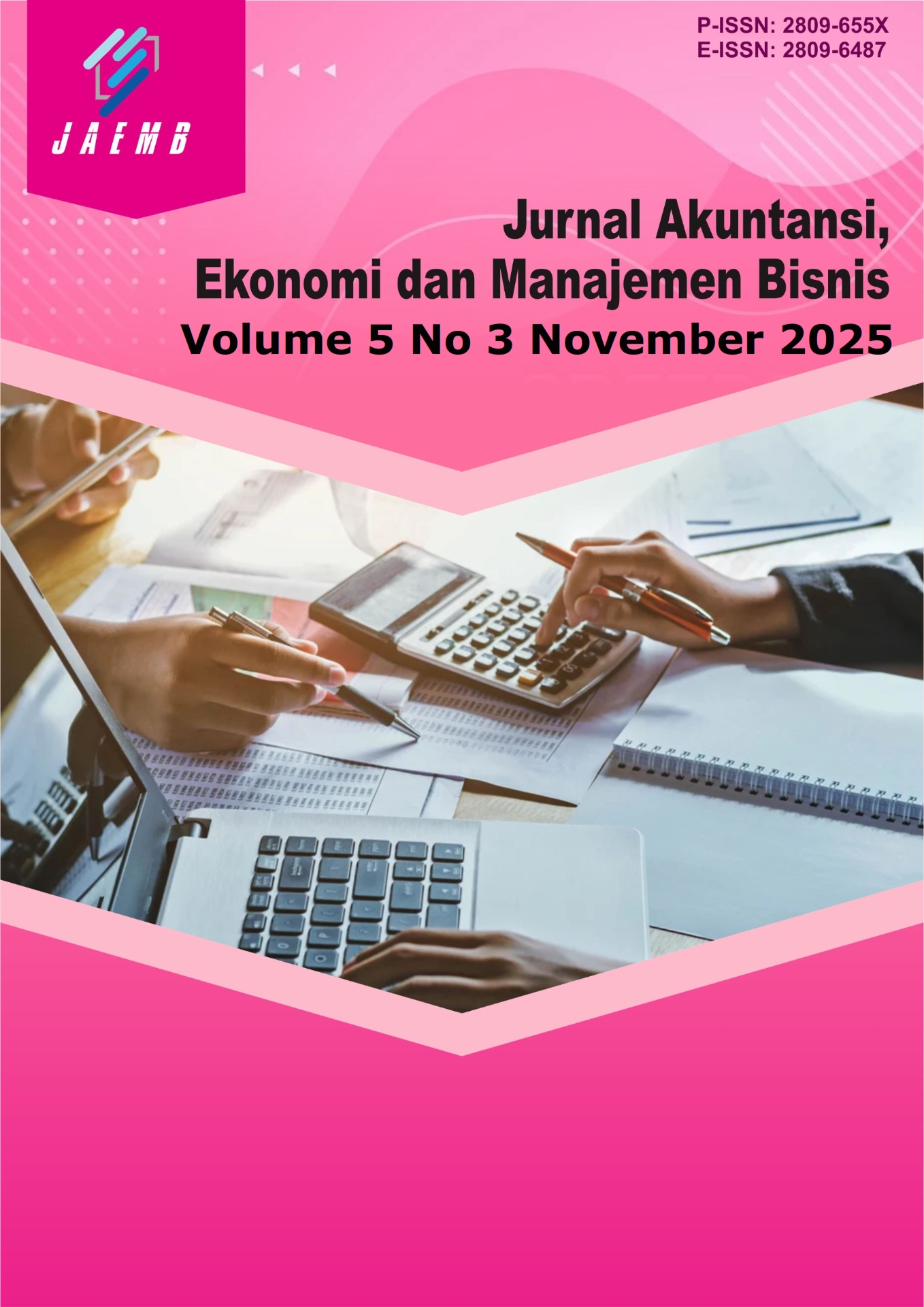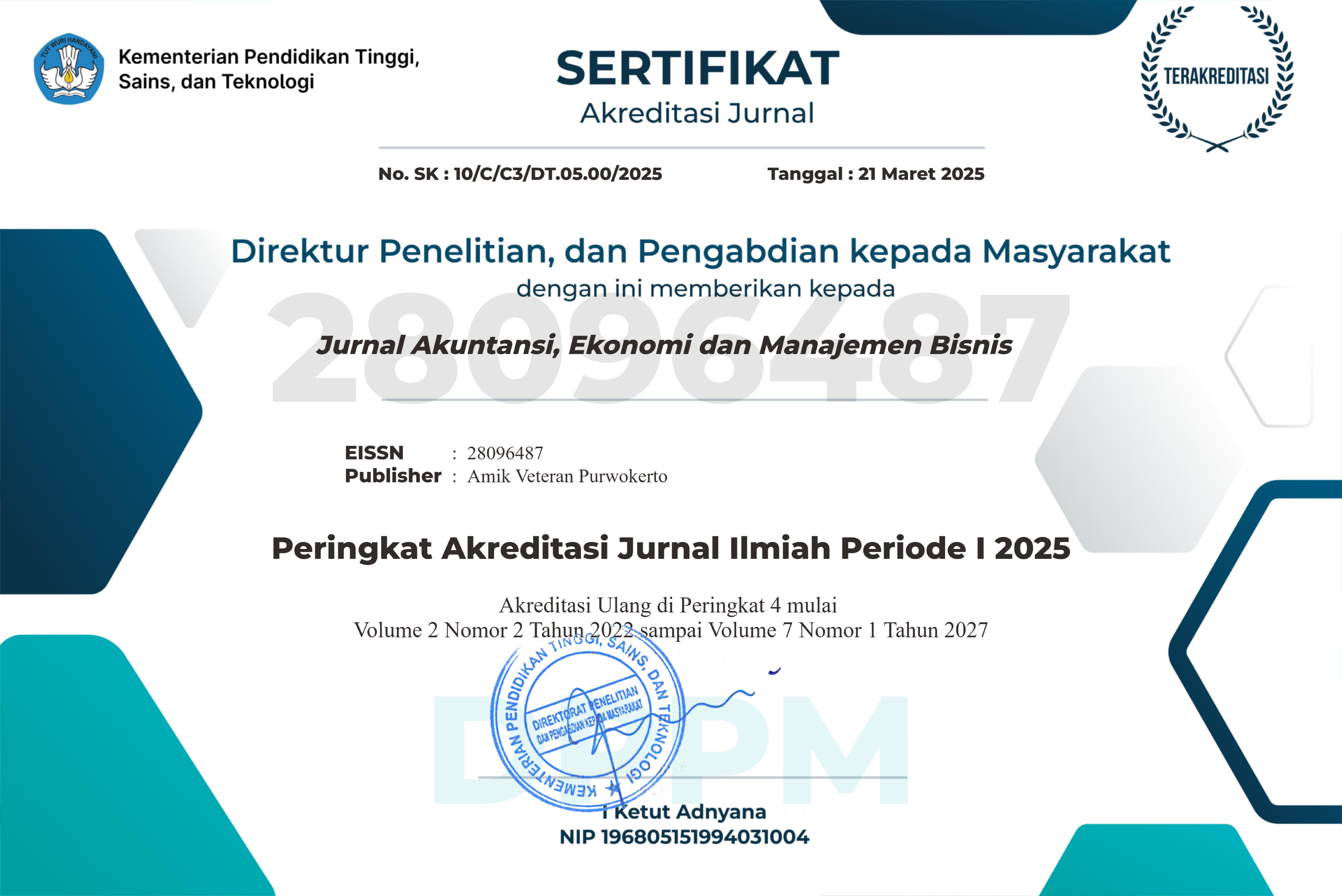Digitalisasi dalam Penganggaran Dana Desa
(Studi Kasus pada Pemerintah Desa Lakuan Toli-toli, Sulawesi Tengah)
DOI:
https://doi.org/10.55606/jaemb.v5i3.7625Keywords:
Budgeting, Community Participation, Digitalization, Village Financial Governance, Village FundAbstract
Village financial management is a crucial pillar for village development and community empowerment. This research aims to conduct an in-depth analysis of the village fund budgeting process at the Lakuan Village Government, Tolitoli, Central Sulawesi. Using a qualitative method with a case study research design, data was collected through in-depth interviews with the village head, village secretary, Village Consultative Body (BPD), hamlet heads, head of financial affairs, and community representatives. Informant selection was conducted purposively, based on their involvement in the village fund budgeting process, totaling 8 individuals from the village apparatus and the community. The results show that the village fund budgeting process in Lakuan Tolitoli has been allocated according to the real needs of the community, with active community participation and the BPD serving as an effective oversight mechanism. The use of the Village Financial Information System (Siskeudes) has significantly eased the budgeting process for the village apparatus. This digitalization not only implies an increase in the accountability of village financial management but also serves as an effective control instrument in budget implementation. These findings underscore the importance of multi-party participation and technology adoption in realizing transparent and accountable village financial governance..
References
[1] T. Kushartono, T. Rohayatin, D. Kurnia, W. Wulandari, and S. Munawaroh, “Peningkatan Kapasitas Pemerintah Desa Melalui Tata Kelola Aset Desa,” Aksiologiya J. Pengabdi. Kpd. Masy., vol. 6, no. 3, p. 451, 2022, doi: 10.30651/aks.v6i3.12963.
[2] M. Rizal and I. Nurhidayat, “Birokrat Melawan: Mempertahankan Integritas di Tengah Budaya Paternalistik (Studi Kasus di Pemerintah Kota Tegal),” J. Integritas, vol. 4, no. 1, pp. 171–198, 2018, [Online]. Available: https://jurnal.kpk.go.id/index.php/integritas/article/view/153
[3] V. Z. Firmansyah and F. Syam, “Penguatan Hukum Administrasi Negara Pencegah Praktik Korupsi dalam Diri Pemerintahan Indonesia,” Integritas J. Antikorupsi, vol. 7, no. 2, pp. 325–344, 2022, doi: 10.32697/integritas.v7i2.817.
[4] A. Imawan and N. Mas’adah, “Transformasi Tata Kelola Dana Desa Untuk Meningkatkan Pendapatan Desa,” J. Akunt. Multiparadigma, vol. 12, no. 3, pp. 689–710, 2021, doi: 10.21776/ub.jamal.2021.12.3.39.
[5] Romadaniati, T. Taufik, and A. Nasir, “Pengaruh Kompetensi Aparatur Desa, Sistem Pengendalian Internal Dan Whistleblowing System Terhadap Pencegahan Fraud Pada Pemerintahan Desa Dengan Moralitas Individu Sebagai Variabel Moderasi. (Studi Pada Desa-Desa Di Kabupaten Bengkalis),” J. Ilm. Akunt., vol. 4, no. 3, pp. 227–237, 2020, [Online]. Available: http://www.ejournal.pelitaindonesia.ac.id/ojs32/index.php/BILANCIA/index
[6] P. Njonjie, G. Nangoi, and H. Gamaliel, “Pengaruh Kompetensi, Sistem Pengendalian Internal Dan Moralitas Aparatur Terhadap Kecurangan Laporan Keuangan Dalam Pengelolaan Keuangan Desa Di Kabupaten Halmahera Utara.,” J. Ris. Akunt. dan Audit. Goodwill", vol. 10, no. 2, pp. 79–88, 2019.
[7] S. Rukmana, F. Syam, N. F. Umar, H. Sakawati, and O. Nur, “Pelatihan Pengelolaan Aset Desa Bagi Aparat Desa Di Desa Sumbang Kecamatan Curio,” vol. 01, no. 02, pp. 31–35, 2024.
[8] N. Syafruddin, “Rincian Dana Desa per Desa TA 2025,” Djpk. [Online]. Available: https://djpk.kemenkeu.go.id/?p=57440#:~:text=Sehubungan dengan ditetapkannya UU Nomor,diatur dengan Peraturan Menteri Keuangan.
[9] N. I. Maharani and H. Widodo, “Accountability of Village Fund Management with the Village Financial System Application,” Indones. J. Law Econ. Rev., vol. 14, no. 3, pp. 6–14, 2022, doi: https://doi.org/10.21070/ijler.v19i4.1179.
[10] N. Y. Yamin, Pendekatan Akuntabilitas Kinerja Sektor Publik. Bandung: Media Sains Indonesia, 2022.
[11] L. Yuniar, N. Yamin, and Jurana, “Accountability: Implications of the Effect of Understanding Government Accounting Standards and Internal Control Against Quality of Financial Statements,” J. AKSI (Akuntansi dan Sist. Informasi), vol. 6, no. 2, pp. 86–90, 2021, doi: 10.32486/aksi.v6i2.18.
[12] S. Paranoan et al., Akuntabilitas Kinerja Sektor Publik. Media Sains Indonesia, 2022.
[13] R. M. Yusuf and S. Paranoan, “Cubizpay: Information System In Credit Union,” Int. J. Account. Manag. Res., vol. 5, no. 1, pp. 1–13, 2024, doi: 10.30741/ijamr.v5i1.1239.
[14] I. A. O. Tempomona, R. M. Yusuf, and S. Paranoan, “Urgensi Artificial Intelligence Dalam Transformasi Akuntan (Si),” J. Akunt. Multiparadigma, vol. 14, no. 3, pp. 536–551, 2023.
[15] D. Afriyanti, H. G. Sabanu, and F. Noor, “Accountability index assessment of government agencies,” J. Tata Kelola dan Akuntabilitas Keuang. Negara, vol. 1, no. 1, pp. 21–42, 2015.
[16] R. I. Lestari, B. Wardono, S. Saptana, I. W. Wardhana, I. Indarto, and Y. Budiati, “The Village Fund Program and Indonesia’s 18th Sustainable Development Goal: A Bibliometric and Content Study,” Int. J. Sustain. Dev. Plan., vol. 18, no. 11, pp. 3505–3518, 2023, doi: 10.18280/ijsdp.181115.
[17] M. Z. Abidin, “Pemulihan Ekonomi Nasional Pada Masa Pandemi Covid-19: Analisis Produktivitas Tenaga Kerja Sektor Pertanian,” Indones. Treas. Rev. J. Perbendaharaan, Keuang. Negara dan Kebijak. Publik, vol. 6, no. 2, pp. 117–138, 2021, doi: 10.33105/itrev.v6i2.292.
[18] M. S. Ir. Hendra Hamid, Manajemen Pemberdayaan Masyarakat, vol. 1, no. 1. 2018.
[19] The Ministry of Finance of the Republic of Indonesia, “LPEFD Laporan Perkembangan Ekonomi dan Fiskal Daerah,” Lpefd, vol. 101, no. 2023, p. 16, 2023, [Online]. Available: https://djpk.kemenkeu.go.id/wp-content/uploads/2022/08/LPEFD-XXIX.pdf
[20] U. Salam, M. T. Dzikrullah, D. P. Febriyanti, and R. E. Adinata, “Enhancing Village Empowerment: Strategic Analysis of Using the Siskeudes Application in Bungah Village,” J. Off. Adm. Educ. Pract., vol. 3, no. 1, pp. 36–51, 2023, doi: https://doi.org/10.26740/joaep.v3n1.p36-51.
[21] M. Munzir, Z. Zulkifli, S. Sabaria, R. F. Wanda, A. Way, and P. O. Marchivanalia, “Assistance in preparing financial reports for houses of worship with ISAK 35 standards in Sorong,” J. Community Serv. Empower., vol. 5, no. 1, pp. 147–154, 2024, doi: 10.22219/jcse.v5i1.29601.
[22] R. Murliasari, “Implementation of Village Fund Management Policy Affirmation in Village Development,” J. Bina Praja, vol. 13, no. 3, pp. 555–567, 2021, doi: 10.21787/jbp.13.2021.555-567.
[23] S. Paranoan, M. Sudarma, R. Roekhudin, and N. Adib, “Dissecting Sauan Sibarrung’s Business Plan Credit Union,” Qual. Rep., vol. 28, no. 4, pp. 1001–1016, 2023, doi: 10.46743/2160-3715/2023.5745.
[24] T. W. Rahmaddhani and N. Prasetyoningsih, “Achieving a Developing Village based on the Village Sustainable Development Goals in Tirtonirmolo Village, Bantul Regency,” J. Penegakan Huk. dan Keadilan, vol. 4, no. 1, pp. 11–29, 2023, doi: 10.18196/jphk.v4i1.16043.
[25] V. U. K. Masbiran, R. Murliasari, A. Afriyanni, and S. N. Wulandari, “Constraint and Strategies Element for Increasing Effectiveness Village Fund Management Based Interpretive Structural Modelling,” J. Bina Praja, vol. 13, no. 3, pp. 445–457, 2021, doi: 10.21787/jbp.13.2021.445-457.
[26] Sugiyono, “Metode Penelitian Kunatitatif Kualitatif dan R&D,” Alf. Bandung, 2017.
[27] Sugiyono, Educational Research Methods Quantitative, Qualitative and R&D Approaches. Jakarta: Alfabeta, 2016.
[28] R. Saha, “Quantitative and Qualitative Approaches to Accounting Research,” Int. J. Multidiscip. Res. Rev., vol. 1, no. 2, pp. 1–6, 2022, doi: 10.56815/ijmrr.v1.i2.2022/1-6.
[29] P. G. Cahyana and H. B. Suprasto, “Akuntabilitas Pengelolaan Dana Desa,” E-Jurnal Akunt., vol. 33, no. 2, p. 556, 2023, doi: 10.24843/eja.2023.v33.i02.p19.
[30] Nikmatuniayah, “Kinerja dan Etika Pelayanan Sektor Publik dalam Upaya Meningkatkan Kepercayaan Masyarakat,” J. Akunt. Multiparadigma, vol. 6, no. 3, pp. 373–384, 2015, doi: 10.18202/jamal.2015.12.6030.
[31] F. Fajrin, F. H., and M. Suwandi, “Good Village Governance: Mencegah Fraud Pengelolaan Keuangan Dana Desa Melalui Aplikasi Siskeudes,” ISAFIR Islam. Account. Financ. Rev., vol. 3, no. 2, pp. 172–186, 2022, doi: 10.24252/isafir.v3i2.30920.
[32] H. M. Kusumastuti, A. B. Jaeni, and A. Himmawan, “Utilization of the Siskeudes Application as a Moderating Variable on the Effect of Accessibility of Financial Reports and Government’s Internal Control Systems on the Accountability of Village Financial Management (Empirical Study in Mranggen District, De,” in ICMS 2023: Proceedings of the 2nd International Conference of Multidisciplinary Studies, ICMS 2023, 12 July 2023, Semarang, Indonesia, European Alliance for Innovation, 2023, p. 135. doi: https://doi.org/10.4108/eai.12-7-2023.2340949.
[33] A. R. Damanik, R. Firmansyah, and A. N. Hafizhah, Enhancing Smart Digitalized System Through SISKEUDES Application in Ensuring Village Accountability. Atlantis Press International BV, 2023. doi: 10.2991/978-94-6463-178-4_9.
Downloads
Published
How to Cite
Issue
Section
License
Copyright (c) 2025 Jurnal Akuntansi, Ekonomi dan Manajemen Bisnis

This work is licensed under a Creative Commons Attribution-ShareAlike 4.0 International License.








